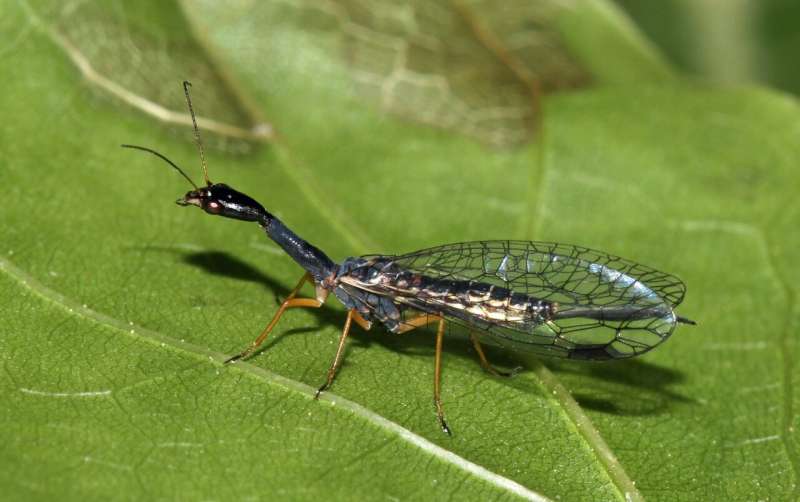This article has been reviewed according to Science X's editorial process and policies. Editors have highlighted the following attributes while ensuring the content's credibility:
fact-checked
trusted source
proofread
First complete genome of a snakefly helps to understand its evolutionary history

Snakeflies (Raphidioptera), also known as camel-neck flies, have gained further notoriety with the selection of the Black-necked Snakefly as Insect of the Year 2022 in Germany, Austria, and Switzerland. These diurnal, predatory insects have a striking shape and live only in the Northern Hemisphere. However, these dainty representatives of the Neuropterida are often overlooked.
Scientists from Frankfurt, Müncheberg and Vienna have now sequenced the entire genome of a snakefly for the first time. The data provide an insight into the evolutionary development of this insect order and enable genomic comparisons.
Snakeflies, usually less than 2 centimeters long, owe their name to their distinctive appearance: The first thoracic segment is very long, as is the head, and both are strikingly mobile and point upwards. The representatives of this group of insects that lived at the time of the dinosaurs already looked very similar.
"We can deduce this from fossils, and accordingly snakeflies can also be described as 'living fossils,'" says Prof. Dr. Thomas Schmitt, Director of the Senckenberg German Entomological Institute in Müncheberg.
"Back then—around 66 million years ago—these insects were much more widespread than they are today, and there were many more species. However, after the epochal impact of the giant asteroid at the end of the Cretaceous period and the subsequent climatic changes, only those species that were able to adapt to the colder temperatures survived."
All of the approximately 250 species known today occur exclusively in the Northern Hemisphere, 10 of them in Germany.
For the current study, published in the Journal of Heredity, the scientists analyzed the Black-necked Snakefly (Venustoraphidia nigricollis), which is widespread in Europe.
"The analysis of its genome is the first complete sequencing of the genetic material of a snakefly. This means that one of the few reference genomes for the group of Neuropterida is now available," says Dr. Magnus Wolf, first author of the study and, since completing his doctorate at the Senckenberg Biodiversity and Climate Research Center, researcher at the Institute for Evolution and Biodiversity at the University of Münster.
"With the 669 million base pairs, we have a huge data set that we will use to understand the genetic adaptations that enabled these 'living fossils' to survive the asteroid impact." The data of the filigree insect was analyzed in the laboratory center of the Hessian LOEWE Center for Translational Biodiversity Genomics, which is based at the Senckenberg Society for Nature Research in Frankfurt am Main.
"The results now allow further research of the phylogenetic analysis of snakeflies under significantly improved conditions," reports Prof. Dr. Ulrike Aspöck, entomologist at the University of Vienna and the Natural History Museum Vienna and an expert on snakeflies.
"They also show that there was probably still genetic exchange between different snakefly species after the asteroid impact because the genomes of the individual species are not completely 'sorted' according to their actual relationship. Our results are a major step forward in the study of snakeflies, but they also show that we still have a lot of research ahead of us before we really understand the ancestry of this ancient group of insects," explains Aspöck.
Snakeflies spend most of their lives, usually two or more years, as larvae. During this time, they feed mainly on eggs and larvae of other insects, including insect pests such as codling moths and bark beetles.
When they finally hatch in early summer, other small, soft-skinned insects, especially aphids and scale insects, are also on their menu. They themselves are preyed upon by birds such as woodpeckers, spiders, and other insectivores.
While snakeflies lay their eggs in the bark of trees and in dead wood, the adult diurnal animals are mainly found in the crowns of trees, especially in sparse mixed forests and in orchards. As they tend to buzz and flutter despite their well-developed wings, they usually remain loyal to their location.
The Black-necked Snakefly was chosen as Insect of the Year 2022 and was thus given the role of ambassador for the insect world in Germany, Austria, and Switzerland. The patron was Leonore Gewessler, Austria's Federal Minister of Environment.
The "Insect of the Year" has been chosen since 1999. The idea came from Prof. Dr. Holger Dathe, then director of the Senckenberg German Entomological Institute in Müncheberg. Every year, a committee of renowned entomologists and representatives of scientific societies and institutions selects a species from various proposals. The Minotaur beetle (Typhaeus typhoeus), which is a protected species, was selected as "Insect of the Year 2024."
More information: Magnus Wolf et al, The de novo genome of the Black-necked Snakefly (Venustoraphidia nigricollis Albarda, 1891): A resource to study the evolution of living fossils, Journal of Heredity (2023). DOI: 10.1093/jhered/esad074





















